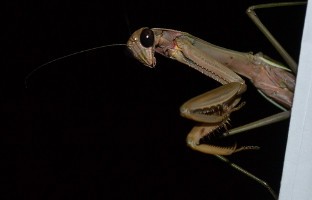The stranger at prayer

At the park a few weeks ago, I clambered up the playground
ladder, pursued by my son. At the top I turned to meet a praying mantis face to
face. It was small and perched on the smooth, domed top of one of the playground's
structural pillars. It looked very much out of place.
"Soren, come look at the praying mantis," I urged my son,
drawing on a reservoir of science nerddom that I thought had been drained
before high school. I picked him up so he could see the creature eye to eye. I
explained that the insect was named for its front legs, which look like they
are joined in prayer.
Soren came back for a few more glances between trips down the
slide. I, on the other hand, was transfixed. How had this thing gotten up
there? How would it get down? It appeared to be looking at me. What was I to it,
I wondered?
Naturally, I thought of St. Simeon Stylites. As described by
Evagrius in his Ecclesiastical History,
Simeon was a Syrian monk devoted to extreme holiness, spending the last 37
years of his life on top of a series of columns. He was an object of
considerable reverence, even drawing Emperor Theodosius II to the base of his
pillar to seek Simeon's guidance and blessing. More than 100 years after
Simeon's death, Evagrius records that his relics were still greatly cherished.
Simeon lacked the means to leave behind a memoir of his
spiritual awakening--and he may also have lacked the desire. Yet others have
been tempted to fill in the gaps left by the striking image of the saint on the
pillar. Alfred Lord Tennyson gave him a Romantic voice, hot and prideful:
...in the night, after a little sleep,
I wake: the chill stars sparkle; I am wet
With drenching dews, or stiff with crackling frost.
I wear an undress'd goatskin on my back;
A grazing iron collar grinds my neck;
And in my weak, lean arms I lift the cross,
And strive and wrestle with thee till I die:
O mercy, mercy! wash away my sin.
It's a splendid poem. But it seems anachronistic, as though a
voice from modernity were irritated by the ancients' refusal to spend much time
recording their introspections. While it may be that the real St. Simeon was as
obsessively jealous of God's favor as the one in Tennyson's imagination,
whatever motives in fact drove him from sheepfold to monastery to mountain
hermitage to pillar are lost to time. If there's a characteristic delusion of
our modern culture, it's that we can enter the sealed vault of the past and
read its secrets in our own language.
As I stared at this stylite mantis, I began to imagine that it
wanted my help. It had large eyes set at the edges of its triangular head, and
as it swiveled they would rest on me. It reached out its praying hands in my
direction--though, I later realized, this is probably what it does to its prey,
too.
I retrieved a piece of paper from our stroller and set it at the
edge of the pillar. After a few cautious tries, the insect alighted. I carried
it to the foot of a tree, which it climbed with astonishing speed. I put my son
on my shoulders so he could watch it disappear into the leaves--a
fast-departing traveler from a silent realm.





